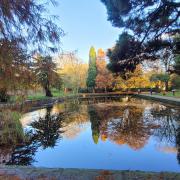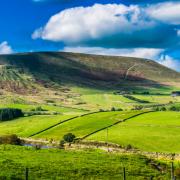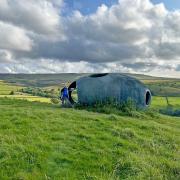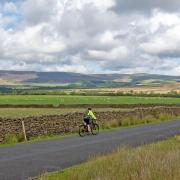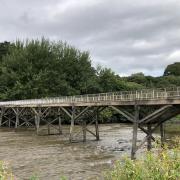There may not be much there but that makes Glasson Dock the perfect spot for a summer stroll, writes Keith Carter
Glasson Dock might never have come into being had it not been for the silting up of the River Lune, making access for shipping to Lancaster more and more difficult. Ships from the West Indies and the Americas regularly docked at Lancaster Quay bringing cargoes of sugar, spices, rum and slaves, so the Port Commissioners obtained permission for a new port to be built in 1787.
Lancaster was trying to keep pace with Liverpool in its maritime development and was desperate to keep the trade flowing. One side-effect of this was the growth of Waring and Gillow who used the mahogany timber from ships’ dunnage to make furniture, growing into a business that became world famous.
It is not hard to imagine a forest of masts crowding the dock at Glasson in its heyday. My earliest recollection is of piles of coal during the 1974 miners strike when tiny ports around the coast were used to bring coal in to try to head off the pickets. I recall transit vans full of police waiting in the lay-bys round Cockerham, expecting trouble which actually never came.
On the map the name Glasson Dock does not appear, only Glasson although everyone refers to it as Glasson Dock. It’s a nice place for a trip out with the family and is usually crowded on summer weekends. Bikers congregate there too, swarming round the snack caravan in their hundreds. The old tub rotting in the marina used to be a favourite place for a cuppa, the Ba-Ba-Gee, a name that will have resonance for many people.
Actually there’s not much to do in Glasson Dock except wander about in the usual British way, watching what limited action there is and waiting for something to happen. But as a place for a walk it’s ideal. The line of the old railway has been transformed into part of the Lancashire Coastal Way and offers easy, level walking suitable for all ages and abilities including wheelchair users. If you choose to you can walk all the way to Caton, a distance of about eight miles. Cyclists love this trail. Anywhere that is traffic and pothole-free is a welcome these days.
This area is a haven for birdwatchers too and on the day I researched this walk there was a long-lens enthusiast on the bridge over the Conder scanning the shoreline for wheatears and ring-plovers.
‘Seen anything interesting?’
‘Everything’s interesting,’ he replied, slightly tetchily. I saw his point. Even the lowliest gull is interesting to the dedicated birdwatcher.
Our walk starts at the large car park in Glasson next to the marina. If the booth is not manned you are trusted to put a pound through a slot in the door. Cross the road and go between the toilet block and the bowling green to meet the shore path. To our left is the Lune Estuary and in the distance you can make out the Lakeland hills to the north and the Bowland Fells to the north east.
After crossing the Conder by an iron bridge we leave the coastal path and turn right just opposite a great little teashop, the Caf� d’Lune, its errant apostrophe likely to cause Lynne Truss’s eyebrow to rise if she were to see it. Never mind the spelling, the coffee is excellent and the toasted teacakes a triumph.
Follow the access road to meet the Lancaster road beside the Stork Inn, a fine hostelry now run by a South African couple where the ales are real and the menu choices unusual. Cross the road to a gap to the right of the telephone kiosk and go right on the side road for a few hundred yards to a brick sub-station next to which is a footpath sign and a stile. Climb this into a field and keep along a right-hand hedge line through two fields to a stile in the bottom corner. Cross this and the stone-slab bridge across a beck then another squeeze stile keeping left, then on rising ground going forward with the hedge now on the left.
As you crest a brow a farm is seen ahead, Parkside Farm, nicely kept, where a stile and gate admit us to the farmyard which we go through between farm buildings. A rough track is our path, the hedge now on our right and when we come to a gateway, go through it and carry on beside the left-hand hedge, � maintaining the same direction. The way marking is non-existent and it is the stiles that give evidence of a right-of-way.
We descend into a dip and pass under power-lines before meeting the next stile in the corner of the field.
This stile takes us into a narrow band of uncultivated land with a metal ladder-stile taking us out of it to enter a field where we need to keep to the right of a large fallen ash tree. Head slightly right to the top of a brow where ahead a line of trees comes into view. This is Forerigg Wood. Look for a stile which enters this wood. Once across it, descend on a narrow path through the trees and leave the wood by a further stile, turning right along a fence line. Where the fence ends, keep ahead through grazing land to meet the Lancaster Canal.
Turn right on the towpath and before long we come to Galgate Marina where colourful narrow boats were being made ready for the season. Shortly after leaving the marina we meet the junction of the canal with the Glasson branch, built to bring goods unloaded at Glasson Dock to Preston and Lancaster. You don’t see much traffic on this two-mile stretch now since it is a dead-end and has five locks to negotiate.
After lock number five a building appears to the right and this is the Mill Inn, a converted flour mill that is now a very nice pub. We continue on the towpath and arrive at the marina, a favourite haunt of the great crested grebe, a bird that performs an unusual mating ritual, male and female craning their necks in unison, their russet-coloured ruffs fully distended, a fascinating display to watch. We follow the path round the end of the marina to arrive back at the car.















